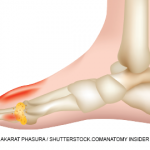 The research presented at ACR Convergence 2021 had a broad scope. Below are details on three studies that addressed cardiovascular safety in treat-to-target strategies, phase 2 study results on the efficacy of tigulixostat and the impact of patient preference on treatment adherence. Take our quiz after you read this article.
The research presented at ACR Convergence 2021 had a broad scope. Below are details on three studies that addressed cardiovascular safety in treat-to-target strategies, phase 2 study results on the efficacy of tigulixostat and the impact of patient preference on treatment adherence. Take our quiz after you read this article.
Treat to Target
Abstract L06: Comparative safety of gout ‘treat-to-target’ and ‘usual care’ treatment strategies on cardiovascular outcomes using observational data: Causal inference approach1
Yoshida K, et al.
Yoshida et al. examined the comparative safety of intensive treat-to-target vs. less intensive strategies for patients with gout using observational real-world and causal inference techniques.
Methods: Using Medicare claims data (2007–2016) linked to electronic health records (EHRs) from two healthcare provider networks, the researchers identified 4,402 patients (mean age 76.9; male 60%) newly diagnosed with gout and with allopurinol or febuxostat initiated. They emulated a hypothetical target trial that compared the risk of major adverse cardiovascular (CV) events (i.e., myocardial infarction, stroke or cardiovascular mortality) of gout patients receiving seven different treat-to-target strategies. (Note: See abstract for details.) Three aspects of treat to target were compared: 1) continuation of urate-lowering treatment (ULT), 2) regular serum urate (SU) monitoring and 3) timely modification of ULT if SU >6 mg/dL.
Conclusion: In this large cohort, Yoshida et al. found a decreased rate of major adverse cardiovascular events with the treat-to-target strategy for gout compared with only initiating ULT regardless of medication adherence. A similar risk of major adverse cardiovascular events was noted for patients on different treat-to-target strategies for gout compared with those who initiated and continued ULT.
Tigulixostat
Abstract L05: Phase 2 study results from a randomized, double-blind, placebo-controlled, dose-finding study to evaluate efficacy and safety of tigulixostat, a novel non-purine selective xanthine oxidase inhibitor, in gout patients with hyperuricemia2
Terkeltaub R, et al.
Gout can be effectively managed by inhibiting synthesis of uric acid. Tigulixostat is a novel non-purine selective xanthine oxidase inhibitor that lowers production of uric acid and was well tolerated up to the maximum dose of 800 mg/day for seven-day administration in healthy subjects in a first-in-human clinical study. This phase 2 study was conducted in the U.S. to assess the efficacy and safety of tigulixostat in gout patients with hyperuricemia and to find the appropriate doses for further development.
Methods: Gout patients with serum uric acid (sUA) ≥8.0 mg/dL to ≤12.0 mg/dL after a wash-out/prophylaxis period were randomized to one of tigulixostat 50 mg, 100 mg, 200 mg, or placebo groups and received the study treatment, once daily oral intake, for 12 weeks. The subjects took colchicine 0.6 mg once daily as a gout flare prophylaxis from the screening period and until the end of the treatment. The primary endpoint was the proportion of the subjects achieving sUA <5 mg/dL at week 12. Non-responder imputation was applied to the subjects who discontinued the study. Secondary endpoints included the proportion of subjects meeting sUA <6 mg/dL at week 12, and gout flare collected using eDiary. Safety was assessed throughout the study including a two-week posttreatment follow-up visit.



